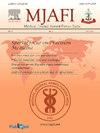Video bronchoscopic electrocautery fulguration of endobronchial carcinoids: Case series from an Indian tertiary care center
Q2 Medicine
引用次数: 0
Abstract
Carcinoid tumors are slow-growing tumors noticed in the tracheobronchial tree and pulmonary parenchyma. Generally, these tumors are slow growing with minimum risk of distant metastasis, but the atypical type of carcinoids has greater malignant potential with lower survival rates. The primary and most effective treatment for all pulmonary carcinoid tumors is surgical resection if no contraindications to surgery exist. Compared to surgical resection, bronchoscopic management is minimally invasive and parenchyma sparing. The present case series describes six patients, all young males, diagnosed with typical (n = 4) and atypical (n = 2) carcinoids, and managed with electrocautery fulguration carried out through video bronchoscope. Three cases were suggested pneumonectomy, while the other three cases were suggested for lobectomy by the Hospital Tumour Board. After the electrocautery fulguration procedure, the procedures of lobectomy or pneumonectomy were successfully prevented in all the cases, thereby saving these young males from life-threatening surgeries and permanent disabilities that would have affected their health and career. This is one of its kind case series that shows the importance of bronchoscopic management in carcinoid cases, from developing countries that can help in preserving the lungs.
支气管内膜类癌的视频支气管镜电灼术:来自印度三级医疗中心的病例系列
本文章由计算机程序翻译,如有差异,请以英文原文为准。
求助全文
约1分钟内获得全文
求助全文
来源期刊

Medical Journal Armed Forces India
Medicine-Medicine (all)
CiteScore
3.40
自引率
0.00%
发文量
206
期刊介绍:
This journal was conceived in 1945 as the Journal of Indian Army Medical Corps. Col DR Thapar was the first Editor who published it on behalf of Lt. Gen Gordon Wilson, the then Director of Medical Services in India. Over the years the journal has achieved various milestones. Presently it is published in Vancouver style, printed on offset, and has a distribution exceeding 5000 per issue. It is published in January, April, July and October each year.
 求助内容:
求助内容: 应助结果提醒方式:
应助结果提醒方式:


